But t’house and allaboardshoops
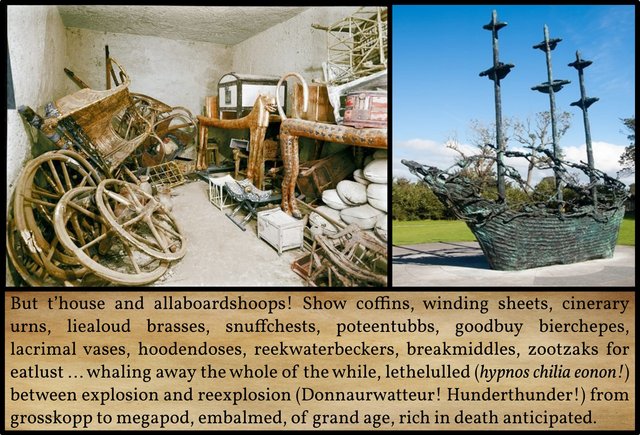
HCE is dead and has just been buried in a tomb that he blasted out of the bedrock at the bottom of Lough Neagh. The next paragraph itemizes the various grave goods and bric-à-brac that will ease his sojourn in the afterlife.
First-Draft Version
Like the previous paragraph, this passage was omitted when Joyce first drafted this chapter in November 1923. But when an early draft of this chapter was published by Eugene Jolas & Elliot Paul in issue 4 of their literary journal transition on 1 July 1927, it included the following lines:
Show coffins, winding sheets, goodbuy bierchepes[,] cinerary urns, liealoud blasses, snuffchests, poteentubbs and for that matter any kind of funeral bric au brac would naturally follow, halas, in the ordinary course, enabling that roundtheworlder to live all safeathomely the presenile days of his life of opulence, ancient ere decrepitude, whaling away the whole of the while, lethelulled between explosion and reexplosion from grosskopp to megapod, embalmed, of grand age, rich in death anticipated. ―transition 4:48
Between 1927 and 1939, when Finnegans Wake was finally published, Joyce only slightly elaborated this paragraph. Other than the addition of some extra grave goods and the expansion of a few phrases here and there, the gist of the passage remained unchanged. The only substantial change was the addition of a brand new opening sentence.
But t’house and allaboardshoops!
Dutch: t’huis : at home. The language of the Netherlands is entirely appropriate in this watery Underworld. The prevalence of Dutch words in this chapter will continue for a few more pages before Joyce finally gives it a rest.
all aboard ship! Continuing the watery theme that has coloured this chapter from its opening line with its references to crocodile tears and the Nile. In the last paragraph there were unmistakable hints that HCE’s underwater tomb might be a submarine, complete with its own conning tower and torpedoes. At least one Joycean scholar has also suggested that the combination of ships and coffins is intended to bring to mind the coffin ships in which the starving Irish fled the Famine:
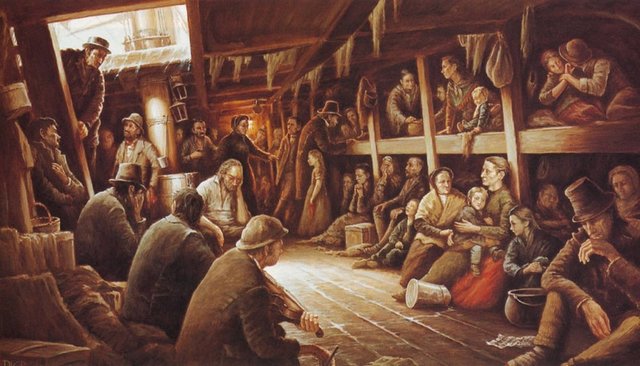
Although emigration had been a feature of Irish life before the Famine, the numbers leaving the country increased substantially during and after the disaster. While the measure saved thousands of lives, many who fled died on board ship, often from disease that was facilitated by overcrowding and poor conditions. Accordingly, the vessels became known as “coffin ships.” Joyce invokes this image in a section that also deals with death and disposal underwater, Earwicker’s burial in Lough Neagh: “allaboardshoops! Show coffins, winding sheets” (FW 77). The summons to board recalls the ships that carried emigrants abroad to escape the devastation. Further, the mention of winding sheets, in which corpses were wrapped while being laid out, hints at poignant similar imagery in Ulysses. In “Hades,” as Bloom remembers the death of his son, Rudy, he muses: “Laying it out. Molly and Mrs Fleming making the bed. Pull it more to your side. Our windingsheet” (U 72). Joyce, thus, reprises in the Wake the linking of personal trauma and communal memory that is demonstrated repeatedly by Bloom and Stephen in Ulysses. ―Donal Manning, “Though Blighted Troth Be All Bereft”: Famine Memory in Finnegans Wake 54
Joyce’s -shoops seems to combine both ships and shops, reminding us that HCE was a tradesman. The list of grave goods sounds like a salesman’s catalogue of items that are available for purchase, as though HCE’s worldly goods are been flogged, now that he is dead and gone. John Gordon’s parenthetical comment is: Even in death, he’s still the huckstering publican. There may also be a reference to the Dutch-German name Schoop or Shoop, but I don’t know anyone with this surname who might be relevant to this passage. In the James Joyce Digital Archive, Rose & O’Hanlon flag Joyce’s notebook entry aboardshoop (VI.B.46:120f) with Note: Dutch, but there is no shoop in Dutch. Ultimately, I cannot account for the second o in -shoops.
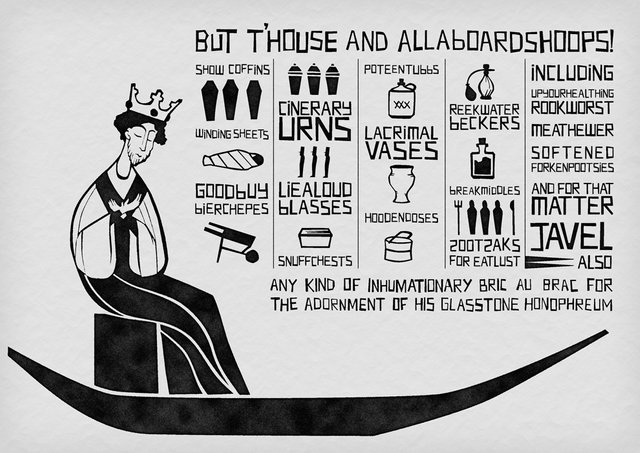
Dutch
t’huis : at home
goedkoop : cheap (literally good buy)
bier = German Bier : beer. Also a bier is a litter for transporting a corpse or a coffin to the grave.
hoedendoos : hat-box, band-box. Also German Hoden : testicles and Dose : box, canister.
reukwater : scented water, perfume. Or reekwater, as Joyce expressed in VI.B.46.
bekers : cups, beakers. also German Bäcker : baker. The butcher, who often accompanies the baker in Finnegans Wake, is the meat-hewer in the next line.
braakmiddel : an emetic
zoutzak: salt bag : a lump of a fellow. Also Modern Greek soutzoukia : smoked sausages.
zoet: sweet : sweets
eetlust : appetite
op je gezondheid! : cheers! (literally up your health!)
rookworst : smoked sausage
vleeschhouwer : butcher (literally meat-hewer, flesh-hewer)
varkenspootjes : pigs’ trotters
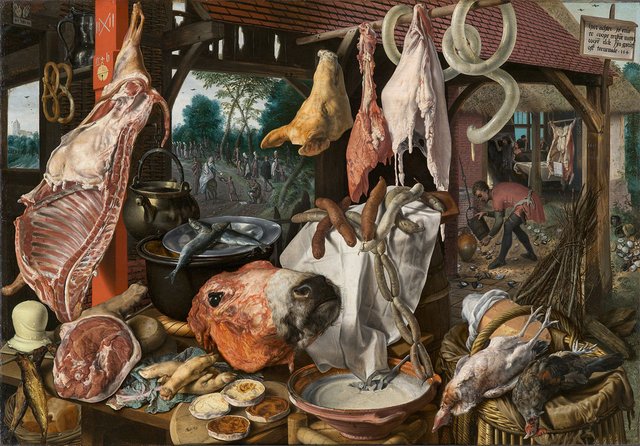
jawel : yes, indeed. Also javel is an obsolete English word for (1) a rascal or worthless fellow (2) a jail (3) a quantity of stalks of flax, corn or other grain laid out to dry in the sun. According to Roland MacHugh’s Annotations to Finnegans Wake, Javel water is a dilute bleach and disinfectant.
met deze trein : with this train
met de trein : by train
konditie : condition
wandeling : a walk, a stroll
ze passen hem : they fit him
lente = German: Lenz : spring, springtime. Also Lent, the part of the liturgical calendar preceding Easter when Christians traditionally fast. All three are named for the lengthening of the days that occurs in spring. Joyce first wrote lents.
stofferig : dusty. Joyce first wrote stuffering, perhaps contrasting the stuffing at Easter that follows the fasting of Lent.
Loose Ends
liealoud brasses
This was later altered to liealoud blasses, but for some reason Rose & O’Hanlon have reverted to the earlier draft. The L/R split occurs commonly in Finnegans Wake, so both readings are valid. brasses evokes the brass plates of a coffin (with their blatant lies, as John Gordon adds), as well as brass instruments in an orchestra, which are certainly loud. blasses evokes the German Blasinstrument : wind instrument. The OED also defines brass as a sepulchral tablet of brass ... bearing a figure or inscription, laid down on the floor or set up on the wall of a church.

to live all safeathomely the presenile days of his life ... ancient ere decrepitude ... of grand age ...
This passage draws upon the following paragraph from Vieillesse et Sénilité [Old age and Senility] by the French doctor of geriatrics Adrien Pic:
Le vieillard est un être humain parvenu à la troisième phase de son cycle évolutif, la phase régressive. Mais les trois étapes successives d’accroissement, d’état et de régression, qui caractérisent ce cycle, ont des limites très variables, en ce qui concerne du moins les frontières de la seconde et de la troisième période. Aussi importe-t-il de fixer tout abord les limites de ce que nous entendrons par vieillesse et par sénilité. Nous étudierons ensuite les différentes phases de cette involution régressive: l'âge présénile, la vieillesse proprement dite, le grand âge et la décrépitude sénile. Nous terminerons dans un dernier chapitre par quelques notions sur l’hygiène du vieillard normal. ―Adrien Pic, _ Vieillesse et Sénilité_ 209
An old man is a human being who has reached the third phase of his evolutionary cycle, the regressive phase. But the three successive stages of growth, stability, and regression, which characterize this cycle, have very variable extents, at least as far as the boundaries of the second and third periods are concerned. It is therefore important to establish at the outset the extent of what we shall understand by old age and senility. We will then study the different phases of this regression: the presenile age, old age proper, extreme old age and senile decrepitude. We will end in a final chapter with some notions on the lifestyle of the normal old man. ―Adrien Pic, _ Old Age and Senility_ 209
Joyce made great use of Pic’s article when drafting the Mamalujo vignette, which would later provide the foundation of Chapter II.4. The article was published in the journal Lyon Médical in 1911, but the following year Pic brought out a book on the same subject: Précis des maladies des vieillards [Summary of the Diseases of the Elderly]. The passage quoted above opens this book, though it was the fifteen-page article that Joyce consulted (Henkes 19).
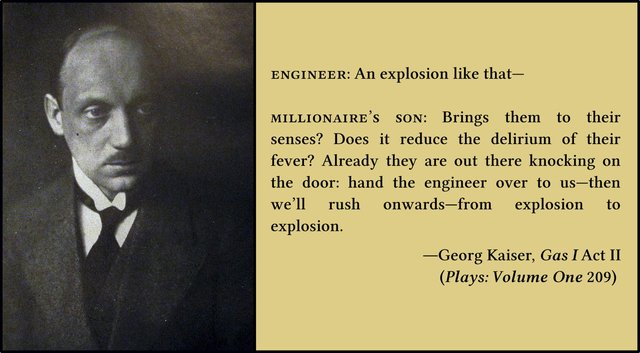
between explosion and reexplosion
In Scribbledehobble (Finnegans Wake notebook VI.A), we read:
life explosion to explosion (George Kaiser):
Georg Kaiser was a German expressionist playwright. Between 1917 and 1920 he wrote his Gas Trilogy, comprising the plays Die Koralle (Coral), Gas I and Gas II. In 1959 the literary critic H Stefan Schultz gave the following analysis of Gas I:
In Gas I (1918), Kaiser grapples with the problem of an industrialized society in which human beings have become mere functions in a productive process. They are proud of their functional character, they are professionals and experts first and foremost; the Engineer is a specialist, the Secretary is a specialist, every worker is a specialist. Then the catastrophy [sic] occurs: the gas explodes. The formula is correct, the manufacturing process is without fault, no human error is involved, nor any mechanical failure. A limit has been reached, the calculations of man are correct in one way, they are incorrect in another way. What is to be done? “Forward, from explosion to explosion” is the general cry which the Billionaire’s Son vainly opposes by a plea for a return to nature. ―Schultz 21–22
In the context of Giambattista Vico’s philosophy, the explosion and reexplosion are the thunderbolts with which God initiates each new Viconian cycle. This interpretation is confirmed by the German parenthesis: Donnerwetter : thunderstorm, while Hunderthunder reminds us that these thunderbolts are represented in Finnegans Wake by hundred-letter words. The German Donau, Danube, is also in there, echoing the allusions in the previous paragraphs to the secret burial of Attila in a river, which is sometimes identified as the Danube. And, finally, in Richard Wagner’s Ring cycle, which also features buried treasure in a river, Thor, the god of thunder, is called Donner. These thunderbolts will continue to resound in the following paragraph.
from grosskopp to megapod
German: Großkopf, big head
Ancient Greek: μέγας, large : ποδός, foot (genitive singular)
This reminds us of the Giant’s Grave, the dominant image in I.1, in which HCE was depicted as a giant interred in the Dublin landscape, with his head under the Hill of Howth and his feet sticking up at Castleknock.
And that’s as good a place as any to beach the bark of our tale.
References
- Robert-Jan Henkes, 2 more weeks in the life of James Joyce as gleaned from his 1923 Notebook VI.B.2 Nativities, Genetic Joyce Studies, Issue 14, Centre for Manuscript Genetics, University of Antwerp, Antwerp (2014)
- Eugene Jolas & Elliot Paul (editors), transition, Number 3, Shakespeare & Co, Paris (1927)
- James Joyce, Finnegans Wake, The Viking Press, New York (1958, 1966)
- James Joyce, James Joyce: The Complete Works, Pynch (editor), Online (2013)
- Georg Kaiser, Plays: Volume One, Translated from the German by B J Kenworthy, Rex Last & J M Ritchie, Calder and Boyars, London (1971)
- Donal Manning, “Though Blighted Troth Be All Bereft”: Famine Memory in Finnegans Wake, New Hibernia Review, Volume 23, Number 4, Pages 44–58, University of St Thomas (Center for Irish Studies), St Paul, Minnesota (2019)
- Roland McHugh, Annotations to Finnegans Wake, Third Edition, The Johns Hopkins University Press, Baltimore, Maryland (2006)
- Adrien Pic, Vieillesse et Sénilité, Lyon Médical, Number 31, Pages 210–225, Lyon (1911)
- Adrien Pic, Précis des maladies des vieillards, Octave Doin et Fils, Paris (1912)
- Danis Rose, John O’Hanlon, The Restored Finnegans Wake, Penguin Classics, London (2012)
- H Stefan Schultz, _German Expressionism: 1905-1925-, Chicago Review, Volume 13, Number 1, Pages 8–24, Chicago (1959)
Image Credits
- The Tomb of Tutankhamun: Harry Burton (Black & White photographer), public Domain : © Dynamichrome (colourized version), Fair Use
- Coffin Ship: National Famine Memorial, Murrisk, County Mayo, © Vincent MacNamara (photographer), Fair Use
- Irish Coffin Ship: Below Deck: © Rodney Charman (artist), Fair Use
- But T’House and Allaboardshoops: © Stephen Crowe (artist), Wake in Progress, Fair Use
- A Meat Stall with the Holy Family Giving Alms: Pieter Aertsen (artist), North Carolina Museum of Art, Raleigh, North Carolina, Public Domain
- Adrien Pic: Memorial Medallion in Honour of Adrien Pic, Jean-Louis Chorel (creator), Public Domain
- Georg Kaiser: N & C Heß (photographers), B Diebold B Anarchie im Drama, Frankfurt am Main (1921), Public Domain
Useful Resources
- FWEET
- Jorn Barger: Robotwisdom
- Joyce Tools
- The James Joyce Scholars’ Collection
- FinnegansWiki
- James Joyce Digital Archive
- John Gordon’s Finnegans Wake Blog
